How to Create a B2B Social Media Strategy
Written by Brian Dean

Today you’re going to see how to create a social media marketing strategy for your B2B business.
The step-by-step plan has helped my B2B company reach 8,945 Twitter followers in less than a year.

And my site now brings in 3,465 visitors per month from social media.
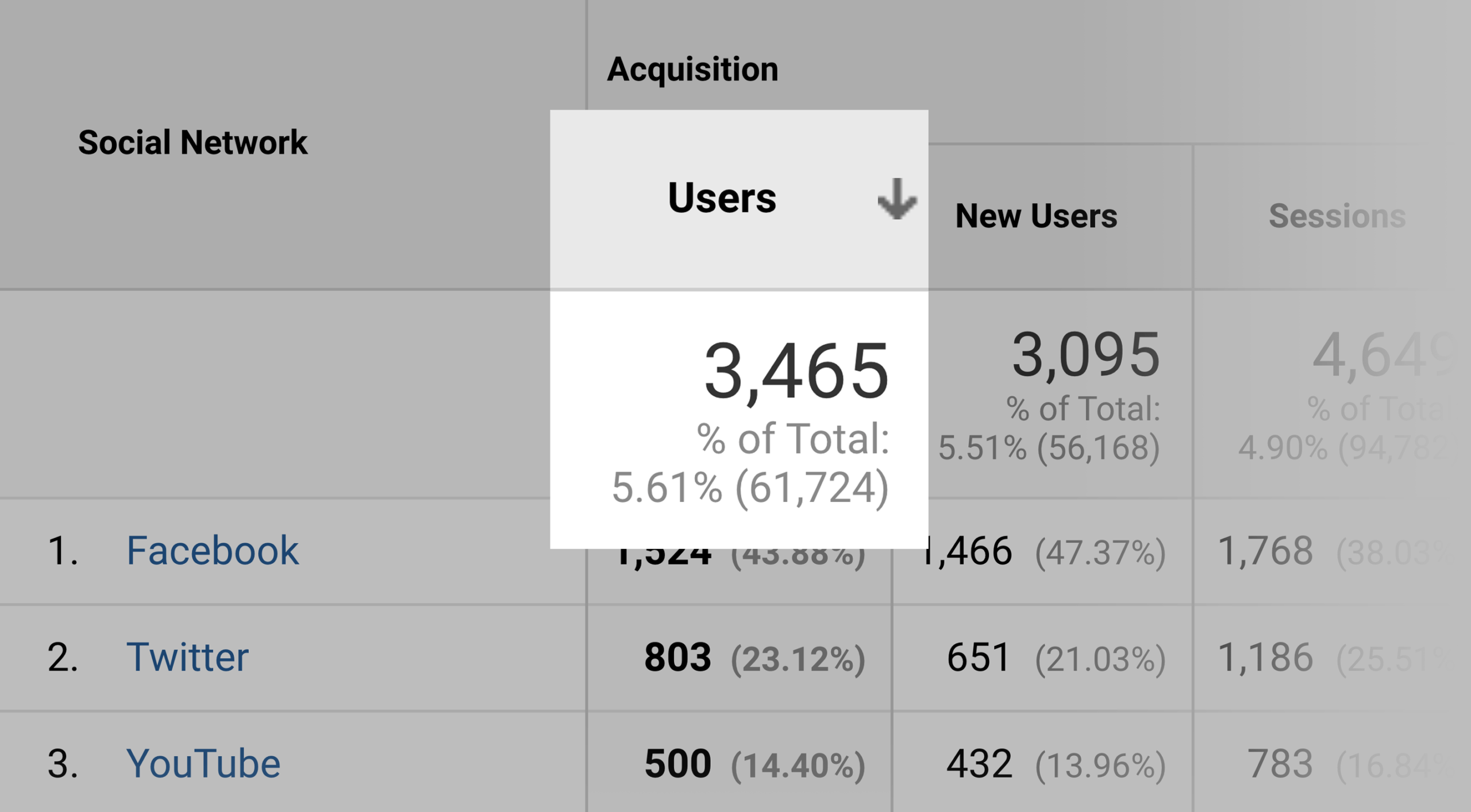
Without further ado, let’s dive right into the specific steps that make up an effective B2B social media strategy.
Step #1: Find Your Focus Platform
Your first step is to identify ONE social media platform to focus on.
Obviously, you can post on several of the most popular social media platforms.
But you definitely want to focus on a single platform at first. Otherwise, you’re going to spread yourself thin.
For example, I launched a new B2B business (Exploding Topics) last year.
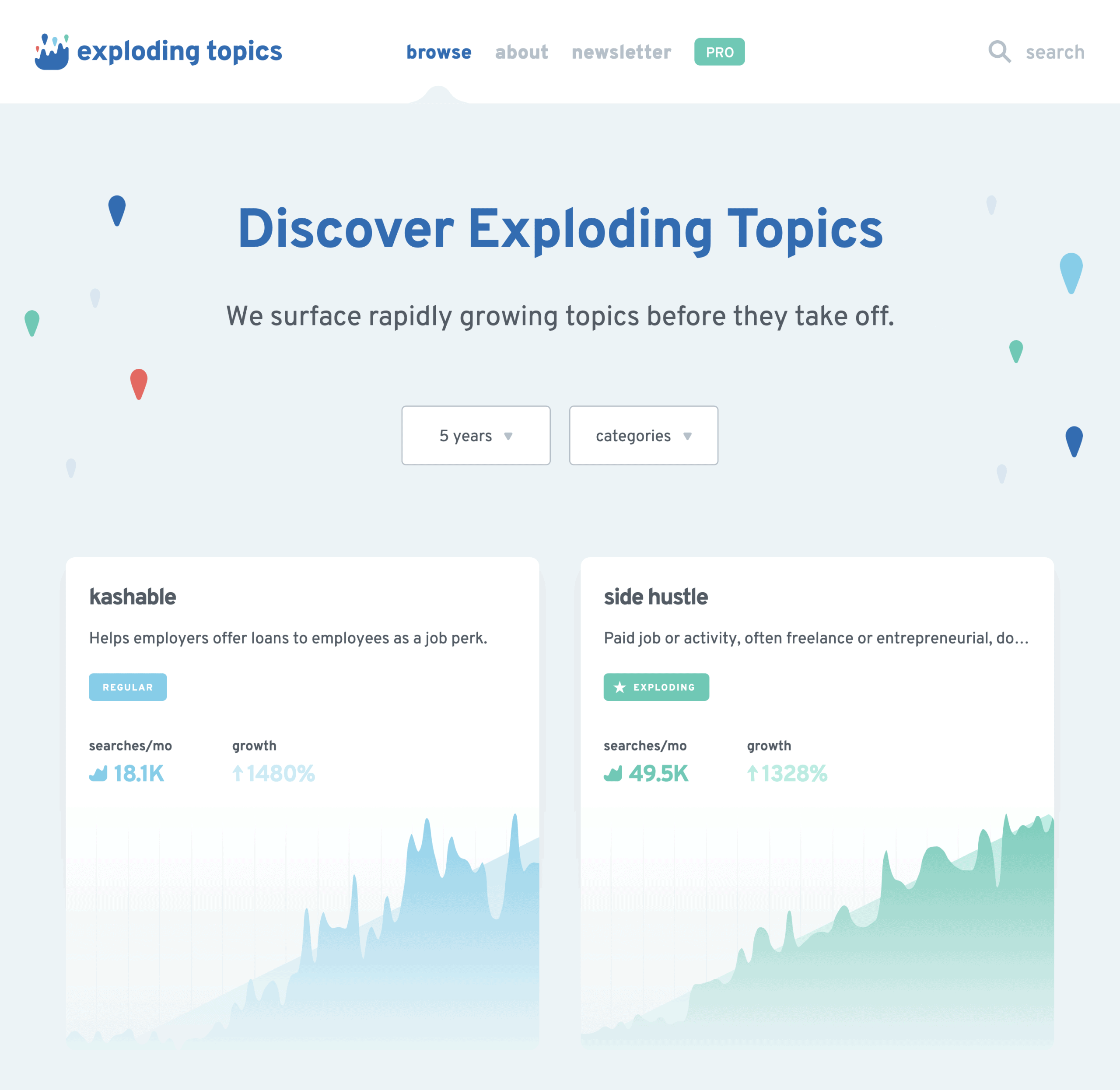
At the time the “team” was made up of two people: me and my co-founder Josh.
And we knew that we didn’t have the resources to succeed on Facebook, Instagram, YouTube, LinkedIn, AND Twitter.
So we decided to focus on one platform at first: Twitter.
Why?
That’s where our target audience hung out.
Our target audience is made up of VCs and investors. And they tend to get their news and information from Twitter.
This is why we focused there.
And it worked!
We quickly built up a decent following on Twitter.
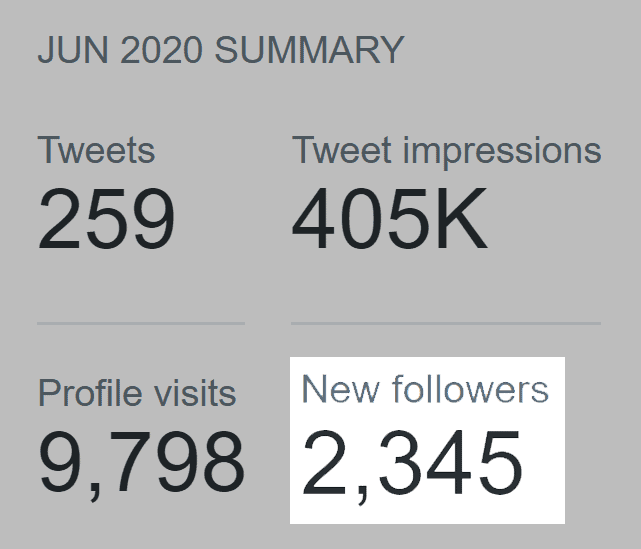
And that following helped drive super targeted traffic to our site. Traffic that ended up converting at over 6%.
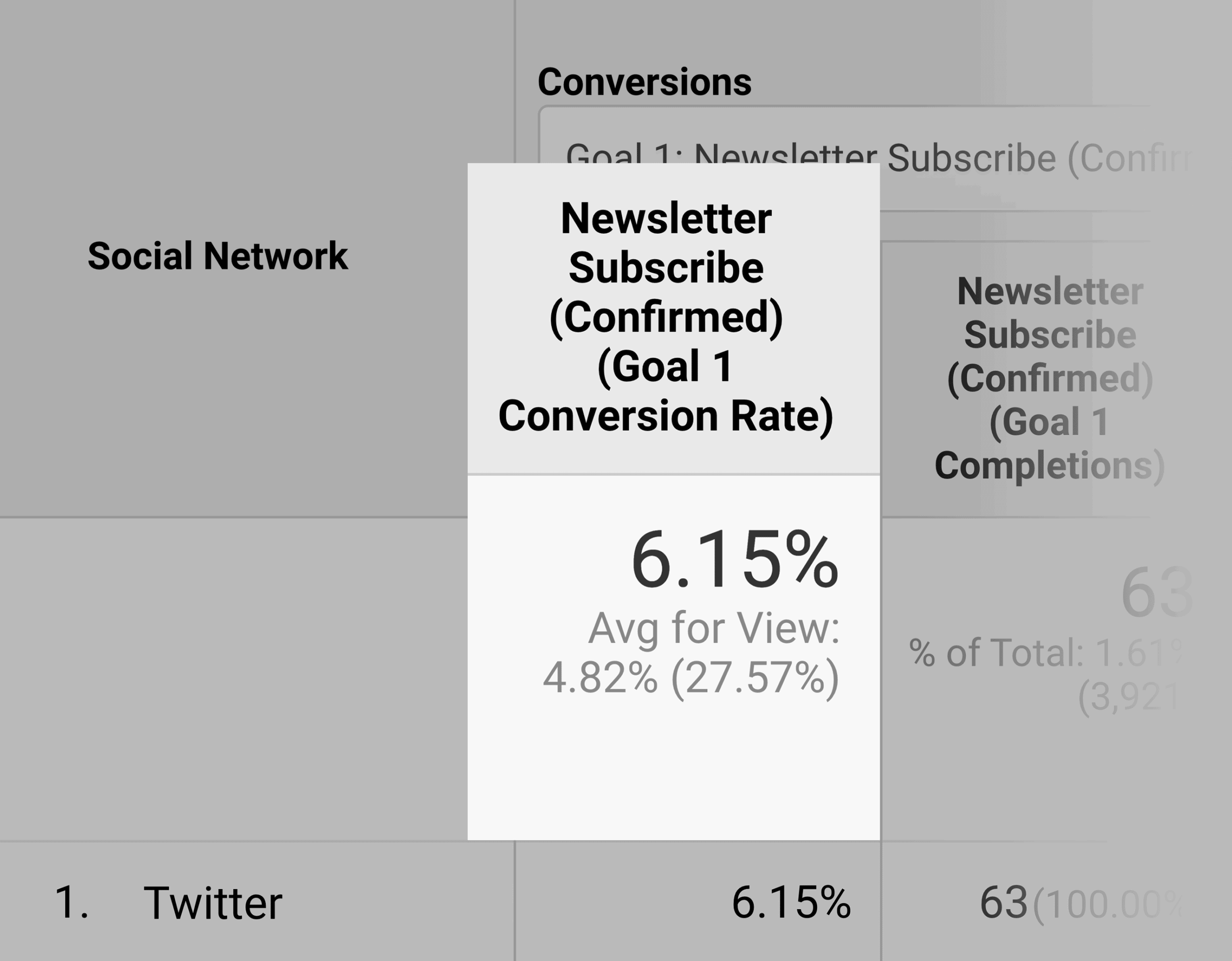
But it’s a little bit different with my other B2B company, Backlinko.
Backlinko’s target audience is largely professional marketers and small business owners.
And they spend a lot of time learning about digital marketing on YouTube.
Which is why I doubled down on YouTube marketing.

So yeah, it’s perfectly fine to have several different social media profiles.
But I recommend pouring all of your resources into one platform at first. Then, slowly branch out.
Step #2: Plan Out Your Strategy For That Platform
OK, so you chose one social media platform to focus on.
Now it’s time to document your approach for that specific platform.
Why is this important?
According to The Content Marketing Institute, only about 1/3rd of B2B companies have a documented social media marketing strategy.
And in my experience, that documentation is HUGE.
That’s because a detailed plan can help you:
- Create content that’s on brand
- Have new staff members get up to speed quickly
- Zero-in on what’s working (or not working)
- Scale up your social media content production
What you include in your documentation depends a lot on the platform that you picked in the last step.
And the audience that you want to get in front of.
But in general, your strategy should focus on one thing:
Getting more followers.
Yes, I know: a lot of people claim that followers are a “vanity metric”.
Sure, focusing 100% on followers doesn’t make sense.
But what a lot of people miss is that your existing followers can help amplify your posts.
Which can get your content in front of new people.
For example:
When I post something to LinkedIn, it gets in front of my 40k+ followers.

Many of my followers engage with my post.
And share it with their network.
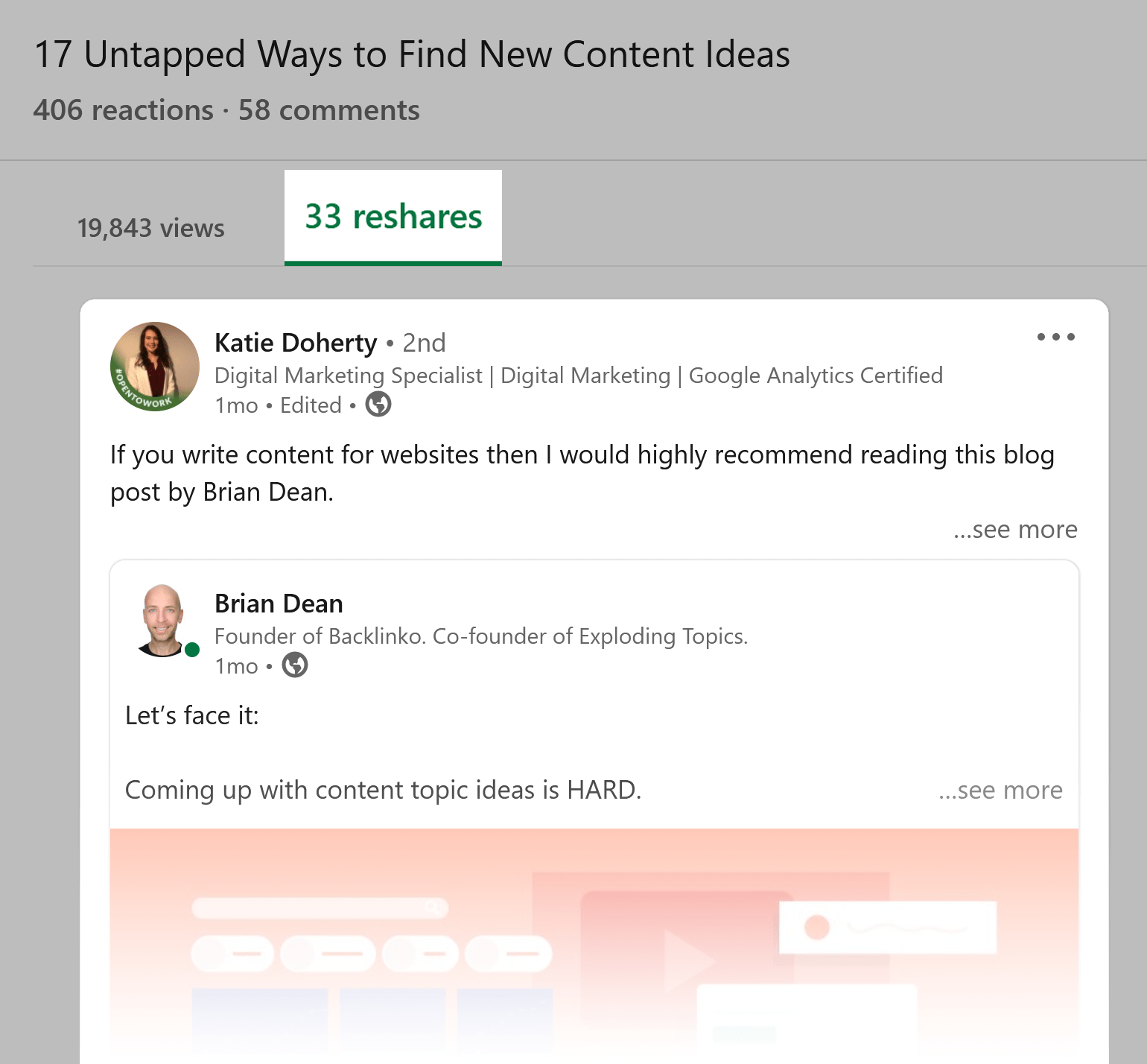
Both of which help my post get in front of their followers. Many of these new people will follow me. And the cycle continues.
In fact, that’s exactly how we were able to build up the Exploding Topics Twitter account so quickly.
We created content that wasn’t necessarily going to get a ton of retweets.

But it was the type of content that would appeal to a very specific group. A group that was likely to follow us after seeing our stuff.
We also funneled people from our email newsletter to Twitter.
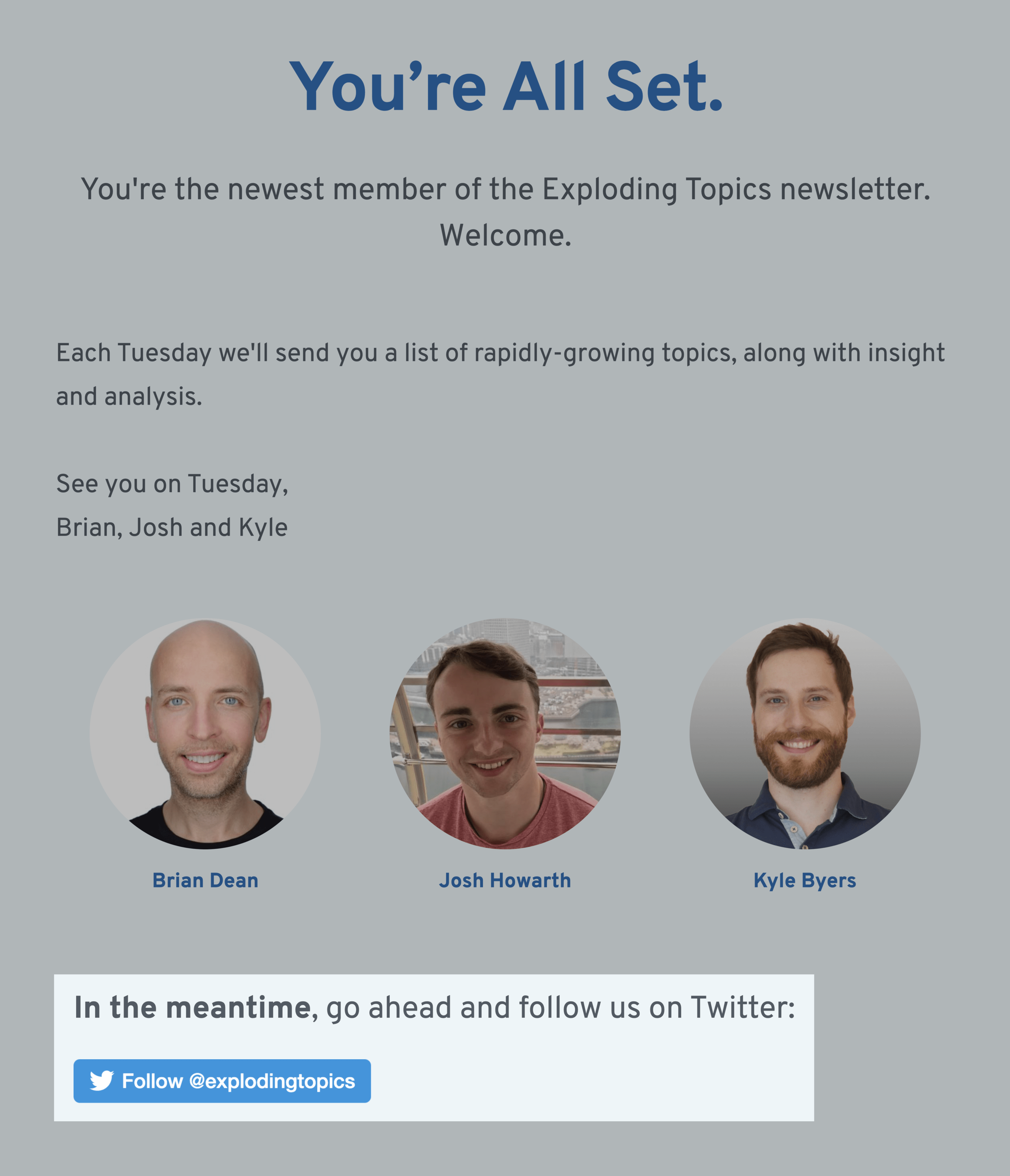
Which helped us get a nice little jump start on growing our following.
So yeah, likes and comments are great.
But I don’t recommend focusing too much on engagement metrics at first. Instead, your goal should be to get as many followers as you can.
Once you have SOME following, you have a small army of people that will amplify your content.
Which makes the rest of the steps in this guide much easier to implement.
Never documented your social media strategy before?
No worries.
This template will help you document your entire B2B social media strategy.
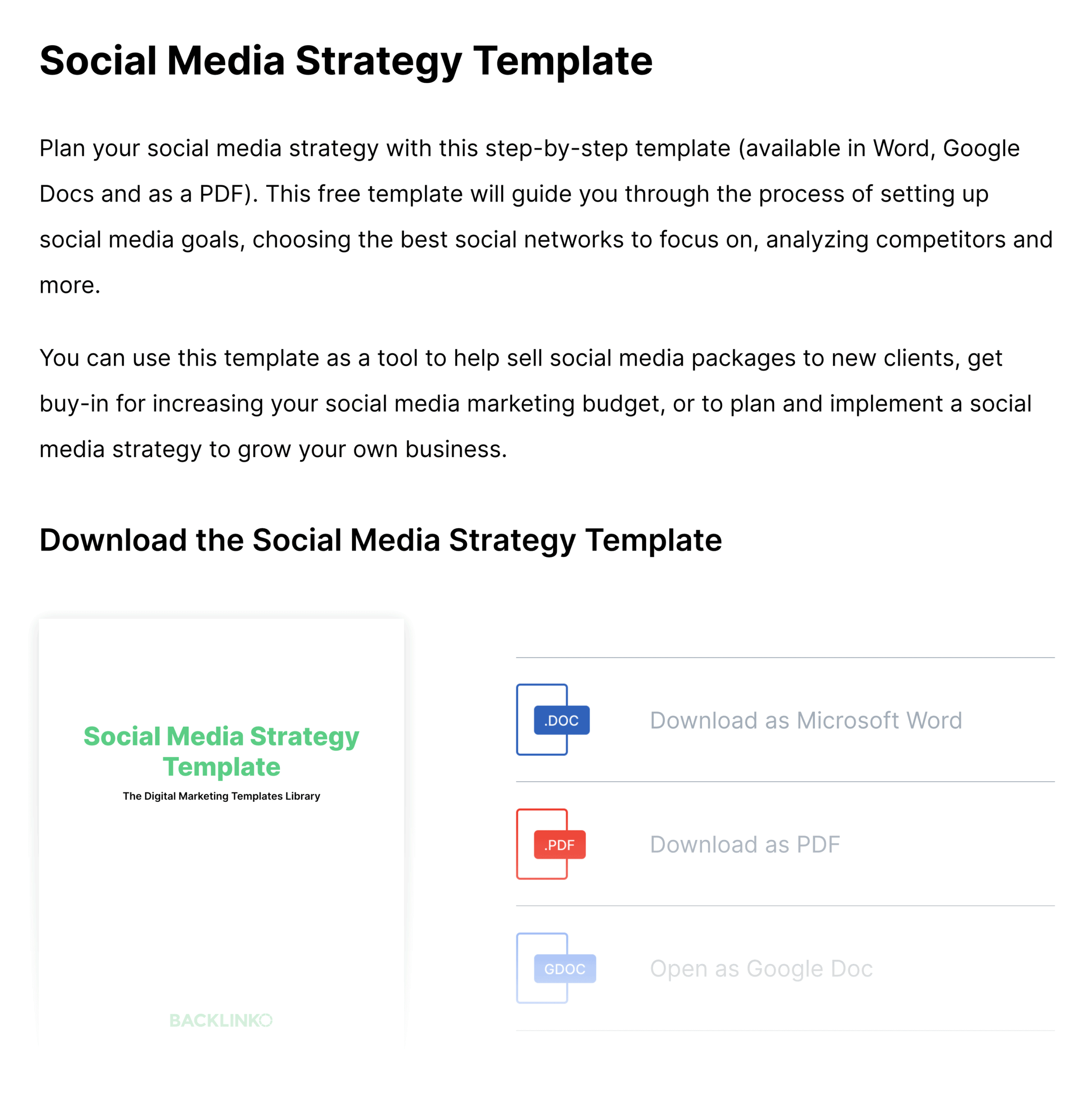
Which leads us to…
Step #3: Create Content for That Platform
Next, it’s time to create and post content on social media.
The type of content you create depends on a) the platform you’re posting on and b) your target audience.
That said, there are a handful of proven content formats that tend to work well on ANY social media platform.
Here they are:
Mini Stories
Remember: it’s called social media for a reason.
This is why stories and anecdotes tend to do well on social.
(Even in B2B.)
In fact, many B2B marketers use social media to broadcast boring updates about their company. Like: “We just hired a new CMO”.
Which gives your B2B business a huge opportunity to stand out.
For example, I tend to share little stories on LinkedIn.
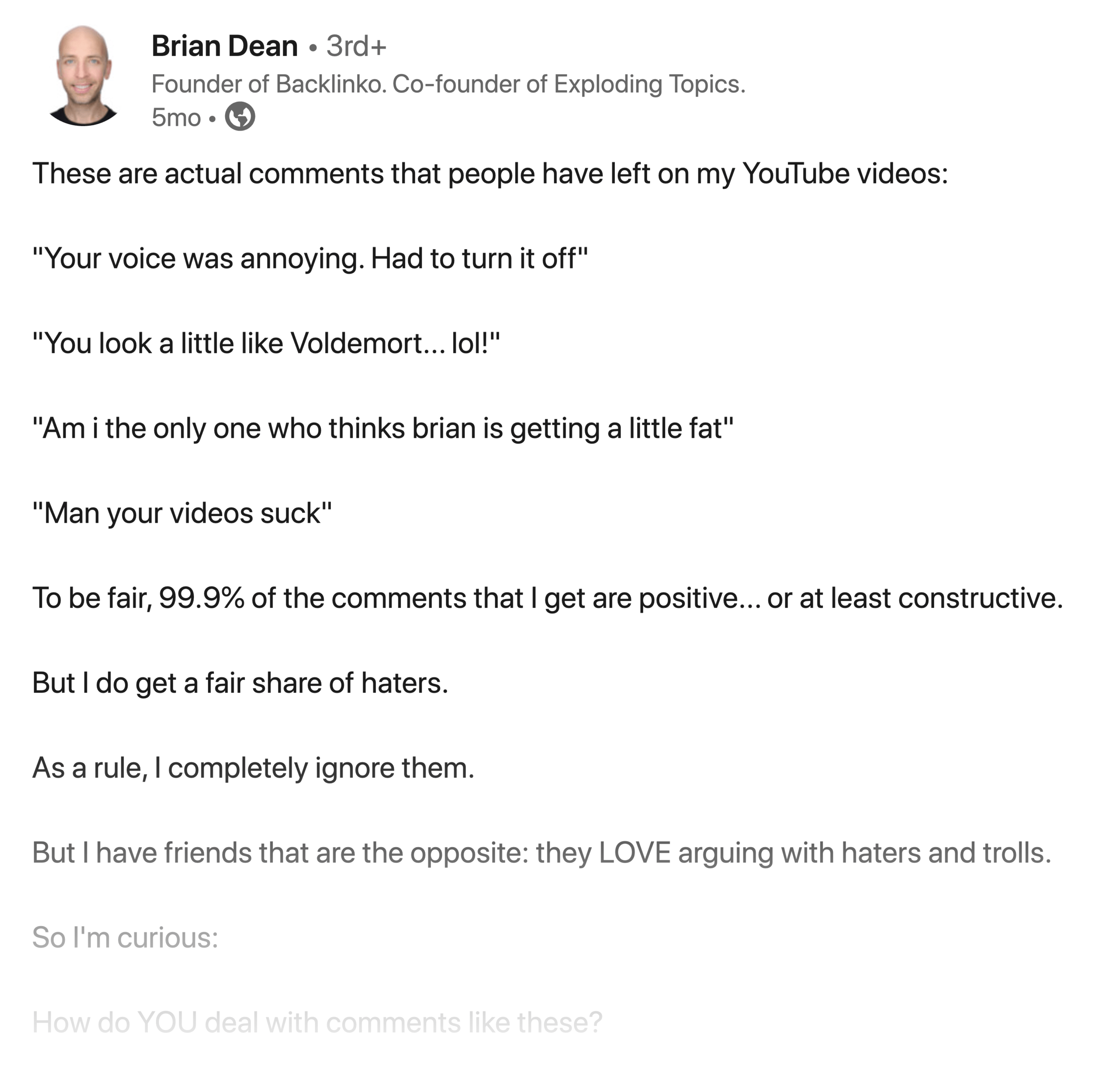
And as you can see, these get really high levels of engagement.

Note that the story wasn’t what I had for breakfast. Or what I think about politics.
It’s essentially a business lesson wrapped in a little story. Which is why it worked so well.
Pro Tip: Ask your staff to publish content on social media.
(Aka “Employee Advocacy”.)
Not surprisingly, posts from people tend to get higher levels of engagement compared to posts from brand accounts.
For example, Claire Lew is the CEO of the B2B company Know Your Team. And she’s prolific on Twitter.
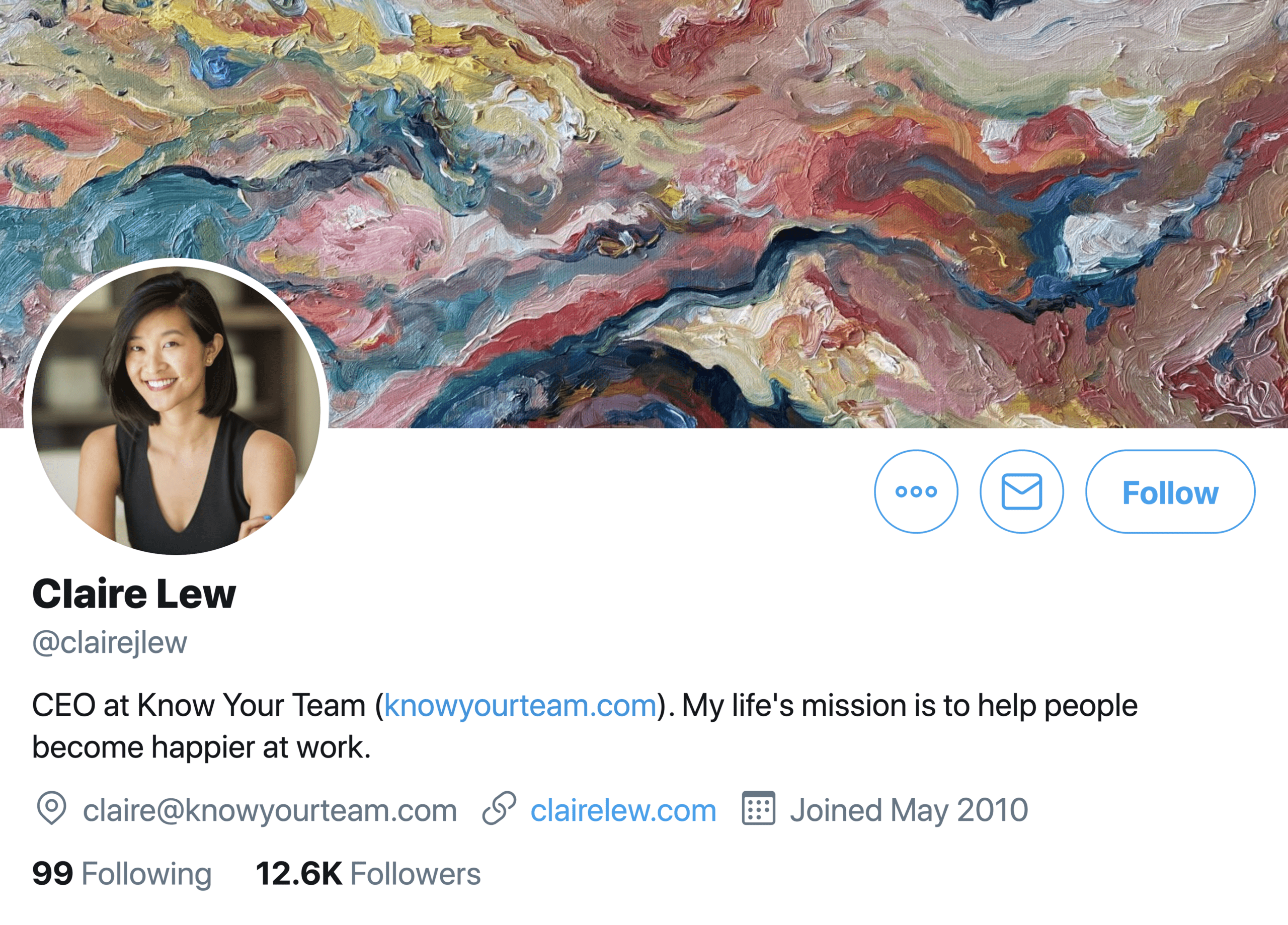
As you can see, she tends to post a lot of company updates. But Claire’s posts have a human touch that helps the posts stand out.

Which makes them more likely to get in front of B2B buyers.
Video Posts
According to data from Google, 70% of B2B decision makers watch at least one video before making a sales decision.
Which means that video ISN’T just for boosting brand awareness.
It’s also a powerful B2B marketing and sales tool.
The type of video that you create depends on the social media channels that you’re focusing on.
For example, long-form video tends to do best on YouTube.
(Largely because longer videos=more watch time=better SEO.)
In fact, most of the videos from my channel at 10+ minutes.
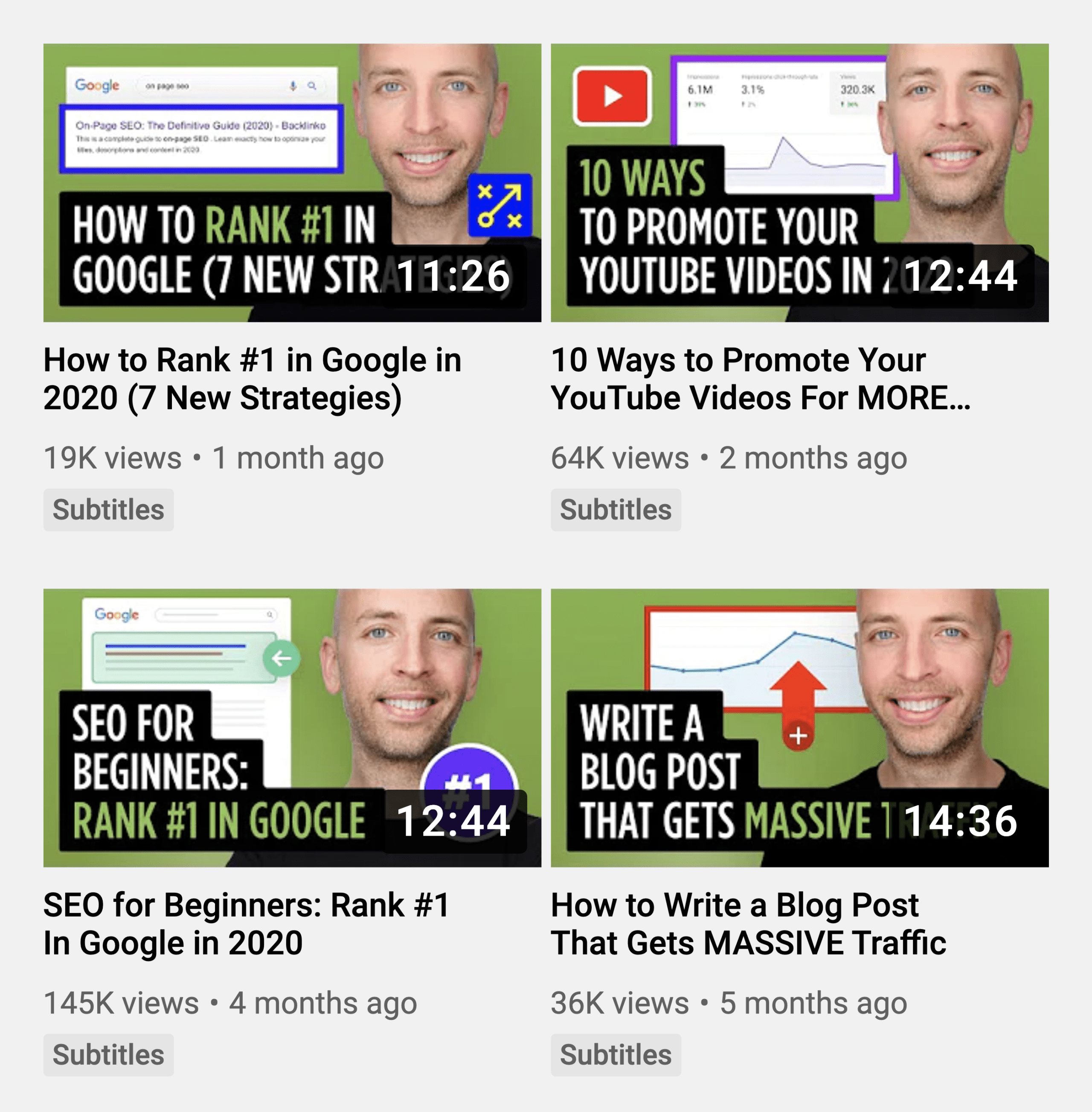
10 minutes is WAY too long for a Twitter video. But it’s perfectly normal on YouTube.
In fact, I’ve posted a number of videos on Twitter.

But they tend to be pretty short (under 2 minutes).
So yeah, video can work really well. Ideally, you’d create your content from scratch for each platform.
But you can also adapt your existing video footage so it will work on the platform you’re going to share it on.
For example, I published this video on my YouTube channel a few years ago.
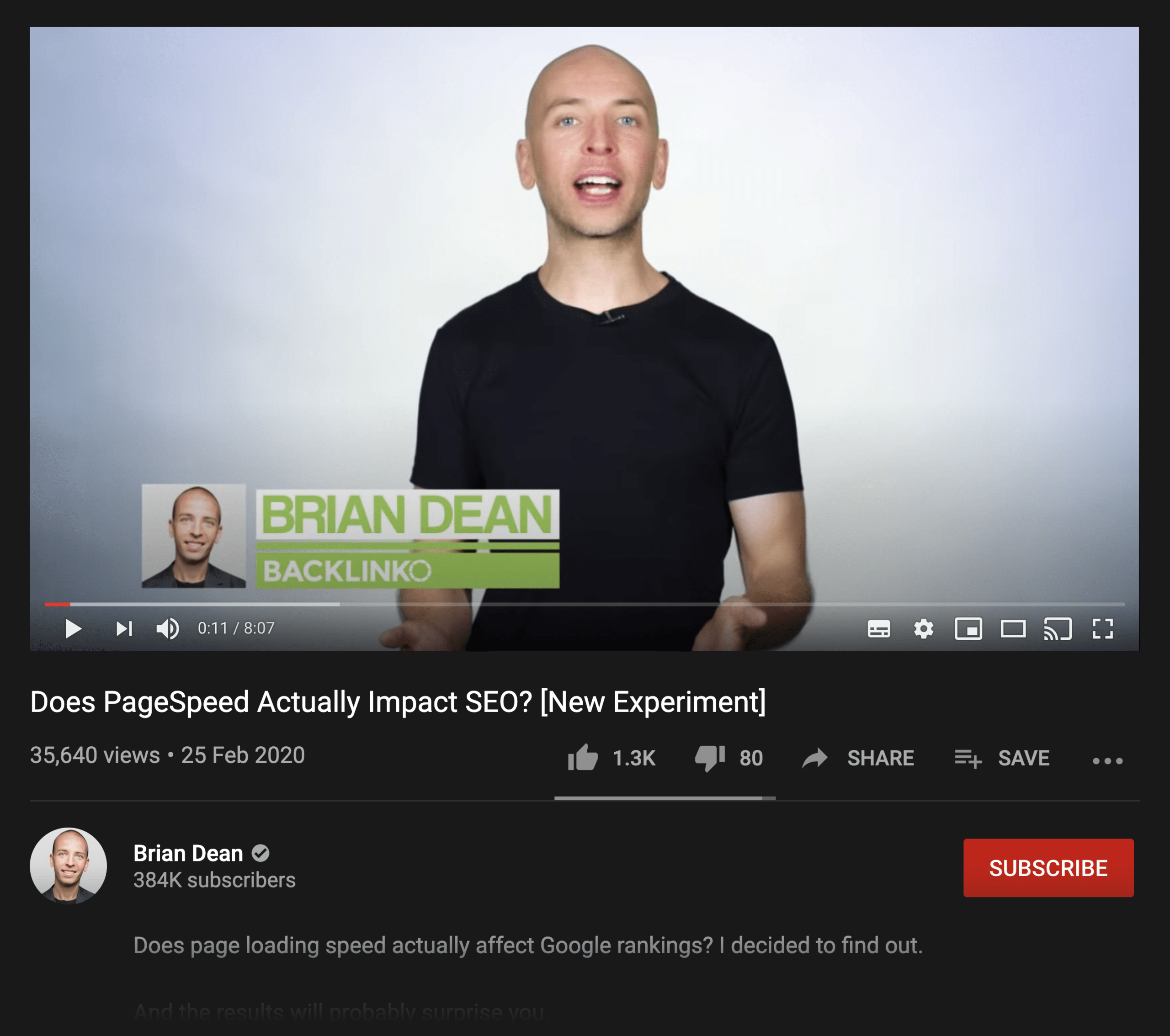
And I wanted to share that video on LinkedIn. But I knew that it was too long.
Plus, that video had an introduction.
Intros can work on YouTube. But they don’t really grab people’s attention in a social feed.
So I cut the intro. And made the entire video about the most compelling strategy from the longer, YouTube version of the video.
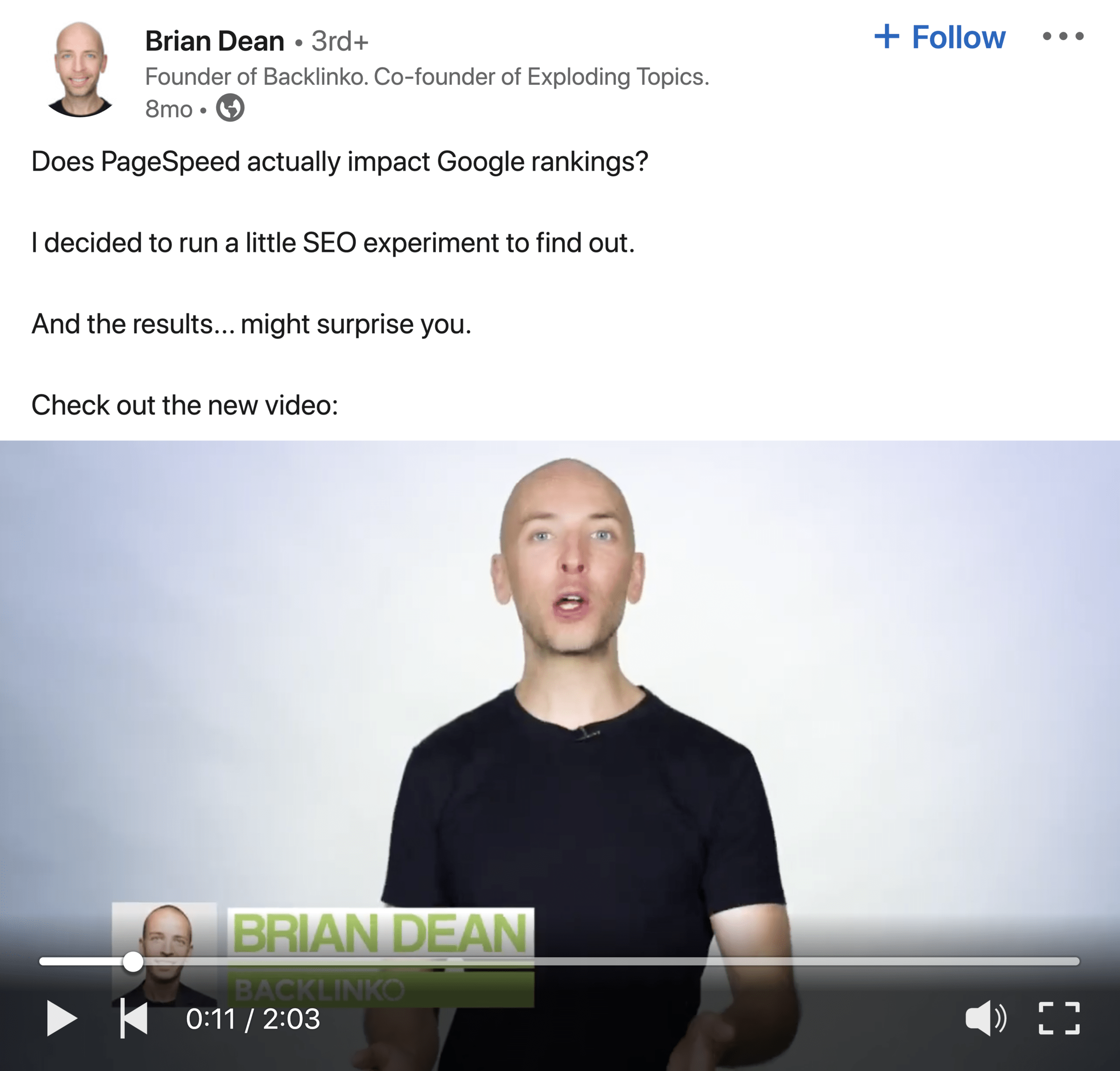
And that post was very well received.
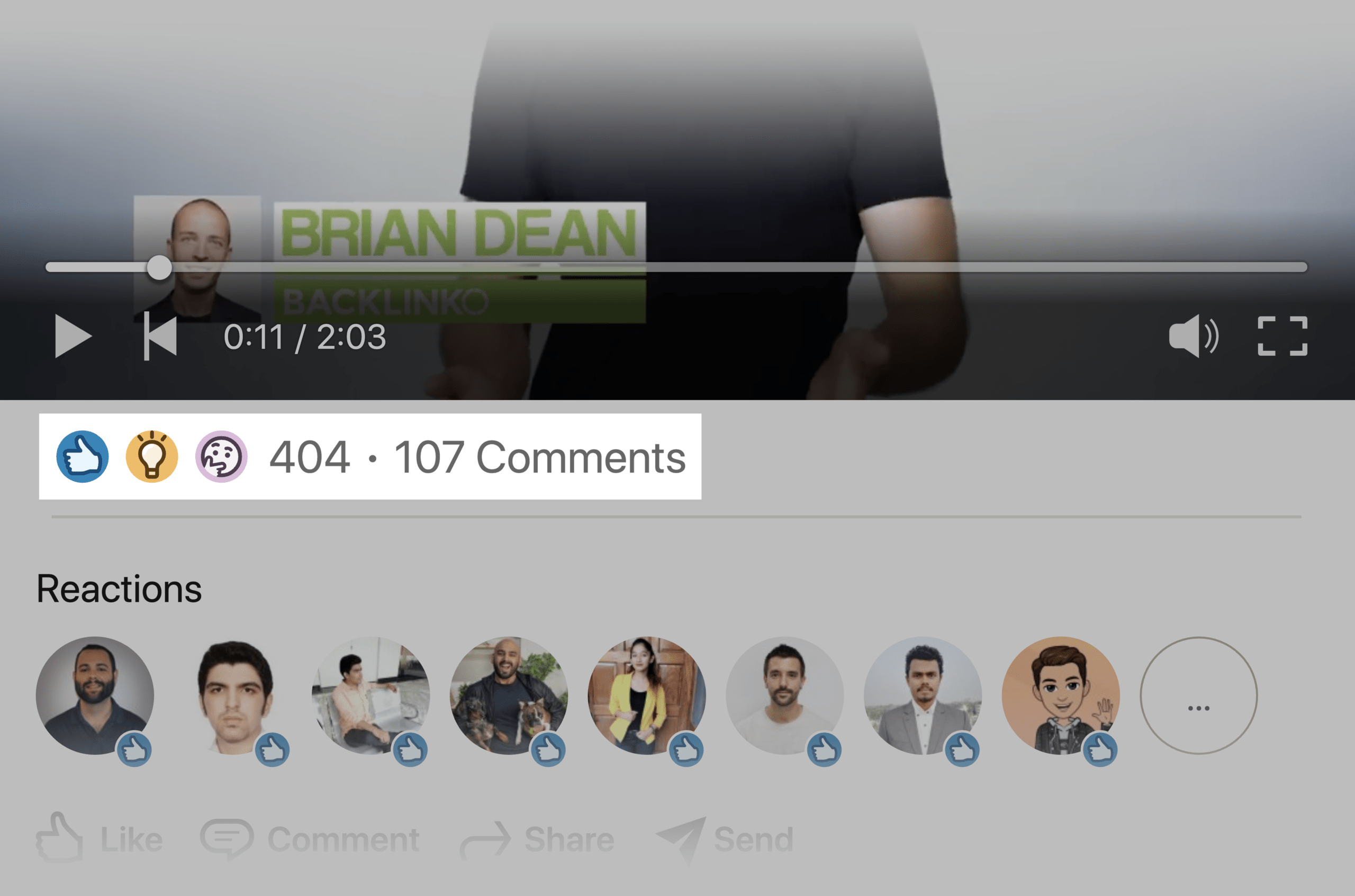
IBM also does a great job of tweaking the format of each video for each network.
In fact, their LinkedIn videos tend to be relatively short (under 2 minutes). And each video is designed to appeal to executives that hang out on LinkedIn.
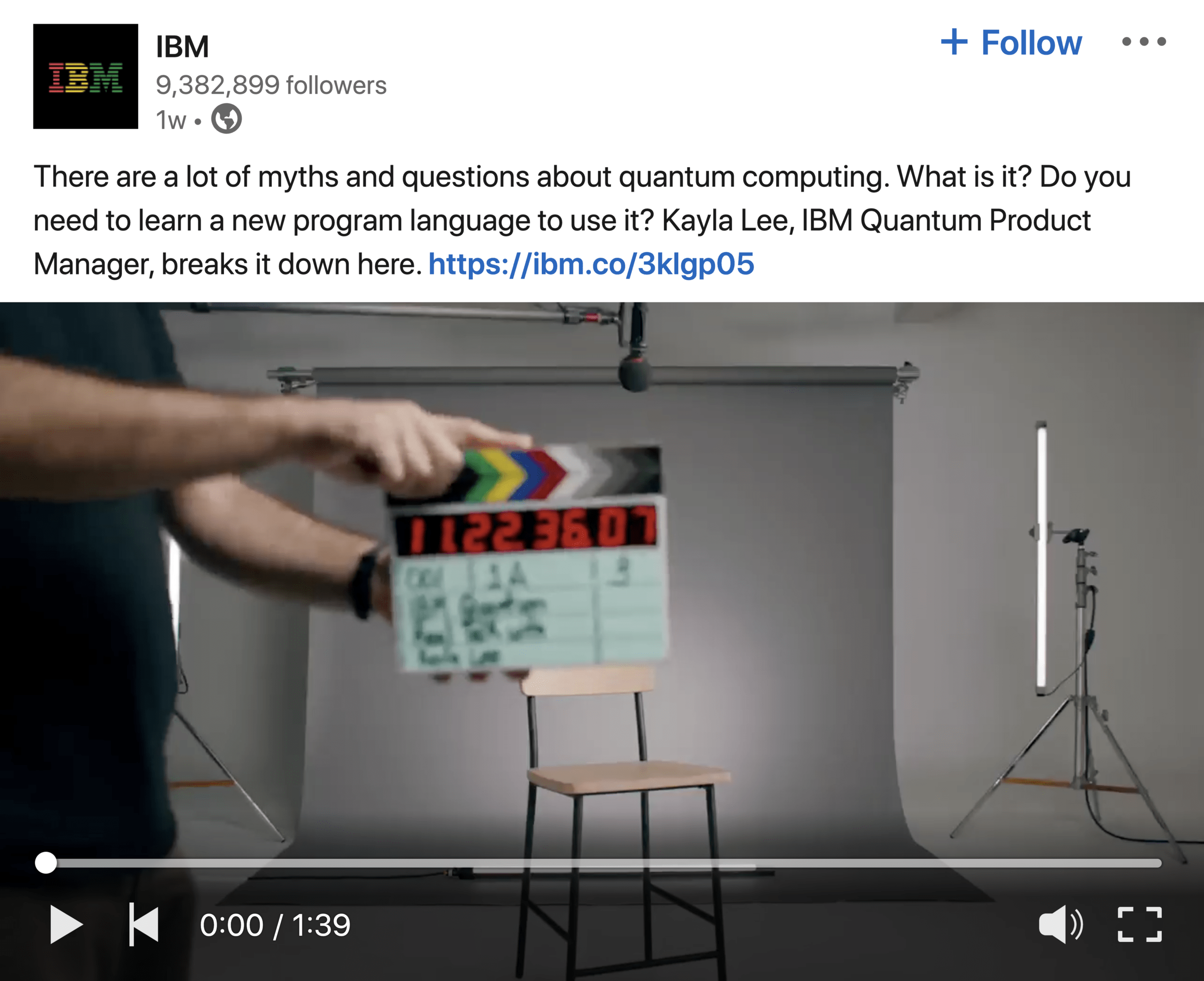
Content Shares
These are posts where you share a piece of content that you published on your blog.
The key to these types of posts is to include some native content in your post.
(Not just a link with a bunch of hashtags.)
For example:
My content share posts used to basically be the title of the post. And a link.

These social media posts got a solid click-through rate. But Facebook, Twitter and other social media sites would choose not to show my posts in my follower’s feeds.
Which makes sense: social media algorithms want to surface content that keeps people on that platform.
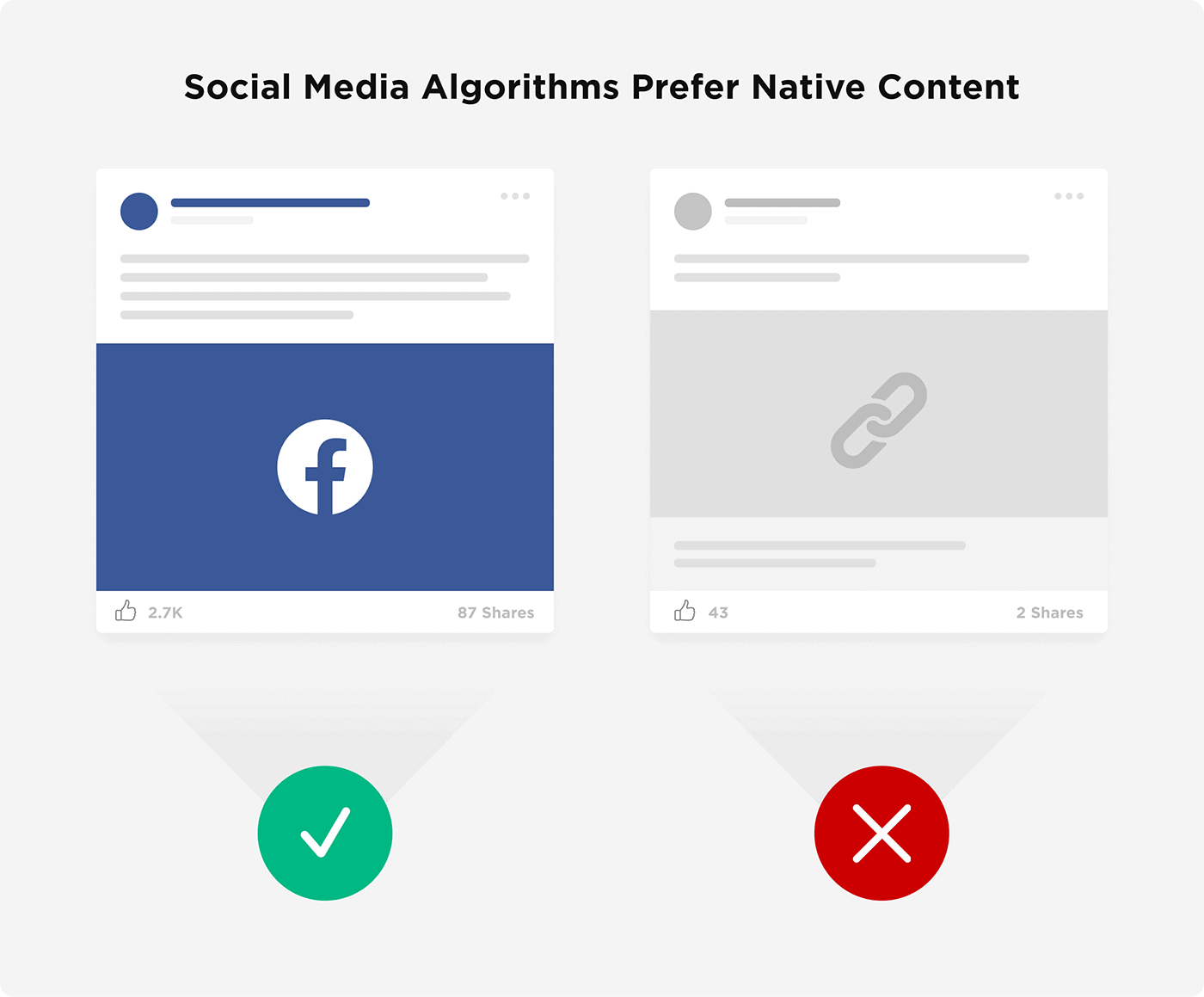
And my posts were designed to do the exact opposite. Which is why they didn’t get surfaced on each platform.
This is why today I tend to add some native content to all of my content share posts.
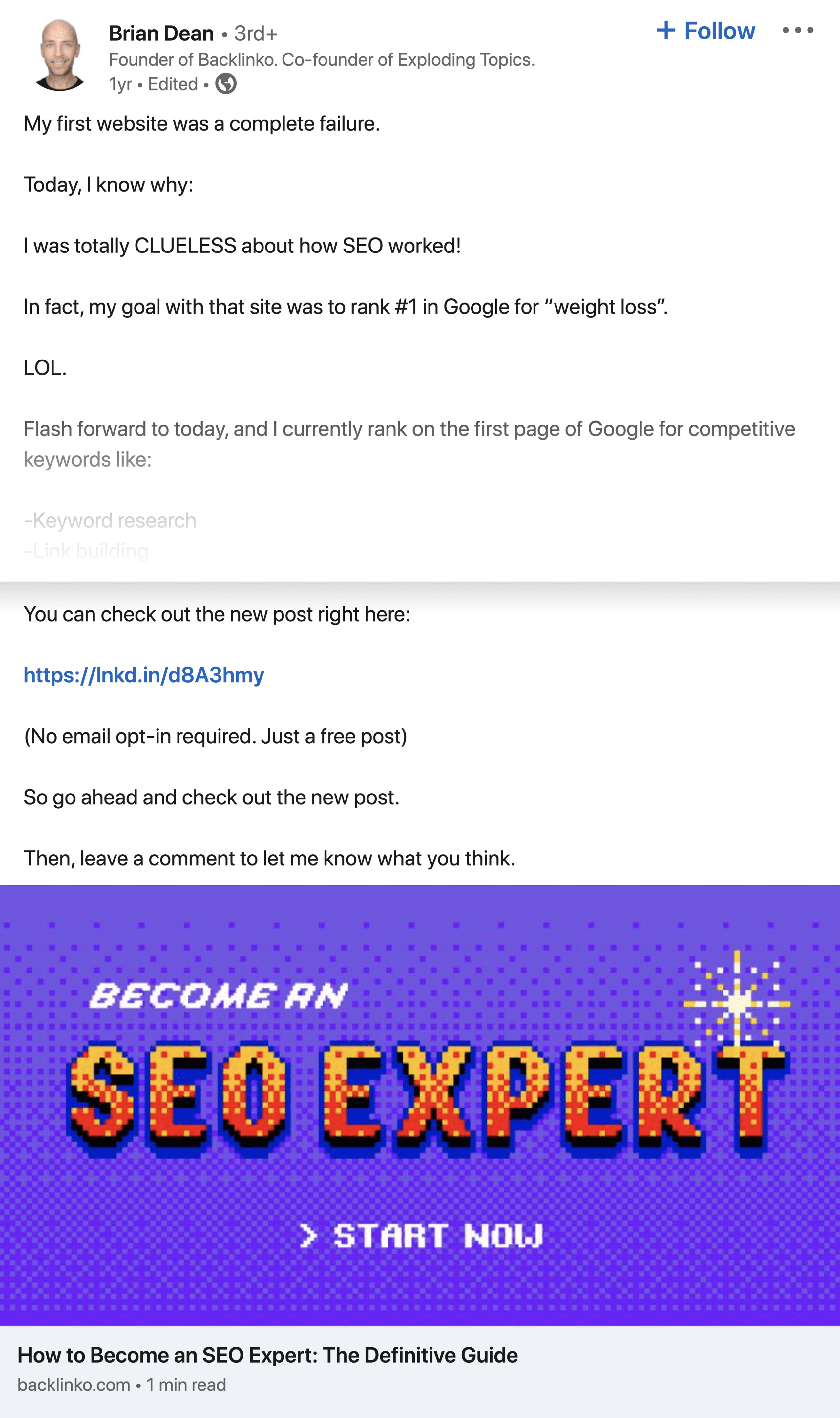
This approach gives you the best of both worlds.
It includes native content. Which makes the social media algorithms happy.
And you have a link back to your post. Which helps drive traffic to your site.
You can obviously include any native content that makes sense for your post.
But here’s a template that tends to work well for me.
Condensed List Posts
List posts tend to get lots of shares on social media.
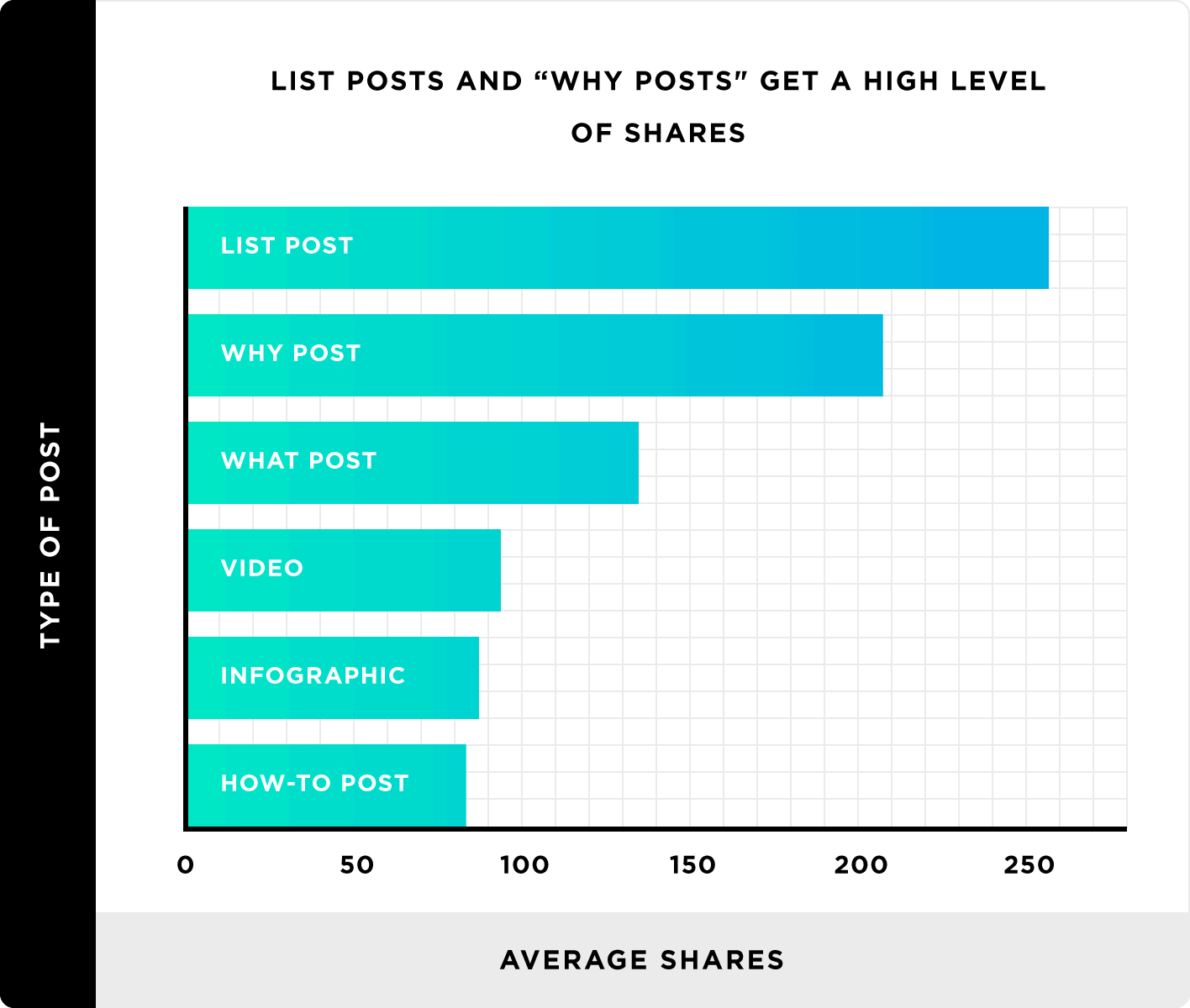
(Especially compared to infographics and how-to posts.)
Which is why list posts are a content marketing mainstay. Especially for blog content.
But you can also publish list posts directly on social media.
Unfortunately, you can’t publish a 2,000 word blog post on Twitter. So you need to condense it a bit.
For example, here’s a list post that we recently published on Twitter.

As you can see, we had to keep the description of each company relatively short. And used a Twitter thread to fit all of the content.
But it still got a decent amount of likes and retweets.

Lesson Posts
These are posts that feature a simple takeaway message, tip or technique.
In my experience, lesson posts work REALLY well for B2B brands.
For example, here’s a recent tweet of mine that included a takeaway lesson.

Nothing fancy. Just a simple little approach that I’ve picked up from hiring dozens of writers over the years.
And that single tweet got 167 retweets and 835 likes.

Engagement Bait
Engagement Bait is any post that’s specifically designed to get high levels of engagement.
So instead of sharing company news. Or a new article. Or a lesson.
You ask your audience a question. And let the responses roll in.
B2C companies use these all the time.
But engagement posts can work well in B2B too.
For example, HubSpot does a great job with these types of posts.
Specifically, they ask questions on social media that they KNOW their audience will want to answer.

Step #4: Promote Your Social Media Content
Like any content that you produce, you need to promote the content that you post on social media.
Otherwise, your content is going to get lost among the millions of social media posts that come out every day.
Here’s exactly how to promote the content that you post on social media.
Cross Promo
Here’s where you team up with a non-competing B2B brand or influencer.
And agree to share each other’s posts.
For example, I recently partnered with former NFL head coach Mike Lombardi.
I agreed to tweet about him.

And he tweeted about us.

Again: Mike and I aren’t directly competing. But our audiences have a lot of overlap.
So it made sense for us to promote each other’s accounts.
Cross Pollination
Cross-pollination is basically sending people between your various social media accounts.
The conversion rate on this approach can be SUPER high. If someone follows you on Facebook, it makes sense that they might want to also follow you on LinkedIn.
A lot of the time, your followers may not even know you’re on LinkedIn.
And a simple post on your Facebook page can send dozens of targeted visitors to your LinkedIn profile.
For example, the Demand Curve newsletter adds a “follow us on Twitter” CTA in most of their newsletters.
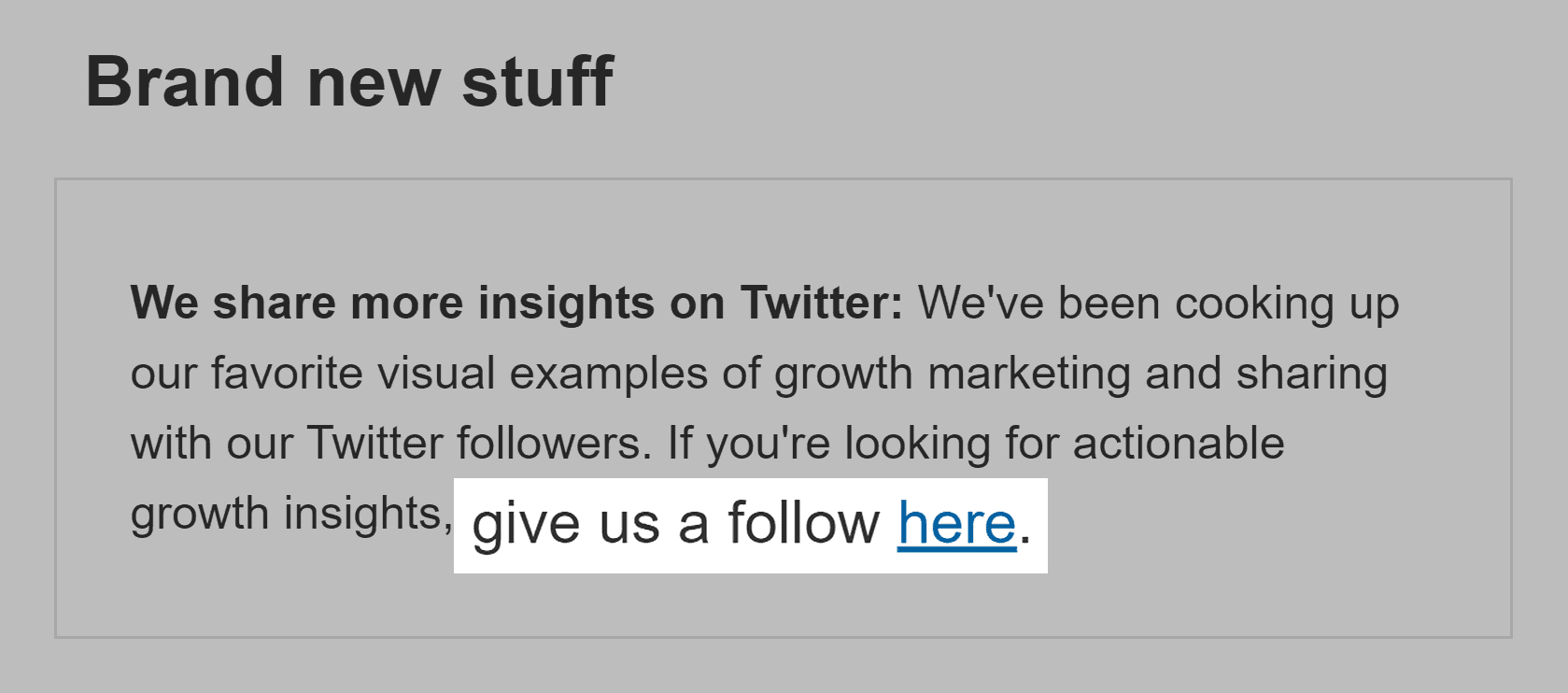
Note how they don’t just say “follow us on Twitter”. Instead, they really sell the content that they post there.
Which makes people more likely to click over. And hit the “follow” button.
Social Media Internal Linking
This is like internal linking on a website. But for social media.
Here’s a real-life example:

See how that works?
We had a tweet that mentioned the growing BNPL trend. So we internally linked FROM that Tweet to an older tweet that went into depth on that topic.
As you know, social media organic reach is… low.
And you’re lucky if 5% of your followers see the content that you post.
This is why this strategy works so well: it gives your followers another chance to see the social media content that you publish.
Step #5: Track and Monitor Your Results
Now it’s time to dig deep into what’s working. And what isn’t working.
That way, you know what to double down on.
Here are some of the key metrics to keep an eye on.
Social Media Traffic
Likes and comments are nice.
But at the end of the day, your social media efforts should lead to targeted visitors to your website.
Fortunately, you can easily see these numbers in Google Analytics.
Acquisition–>Channels–>Social

In my case, we’re getting a decent chunk of traffic from Twitter. Which makes sense. That’s our focus platform right now.
And over the long-term, we’re getting more traffic from Twitter than before. Which means our approach is working.
Total Conversions
Again, this is easy to see in Google Analytics.
Just check out the conversions column.

In our case, we’re getting a decent number of conversions from Twitter. But honestly, it could be better.
So this is something I’d look to improve. Maybe by posting different types of content. Or by sending people to a more targeted landing page.
Followers
Like I mentioned way back in Step #2, your goal in the early days should be to build up a following.
That way, you have people that can amplify the content that you publish.
Fortunately, most social sites offer some sort of analytics tool to help you track your followers over time.

(Some social networks, like Facebook, even provide demographic info on your followers.)
Engagement
Engagement is probably the least important metric on this list.
But it is worth keeping an eye on.
After all, no engagement=your content isn’t working.
On the other hand, engagement can easily be a vanity metric.
It’s easy to get 100s of likes.
But if no one actually comes to your site and converts? That post didn’t really help grow your business.
So I recommend keeping an eye out for engagement. But I wouldn’t make it your main focus.
Instead, you want to focus on publishing social content that leads to targeted site visitors. And conversions.
Step #6: Iterate and Improve
Now it’s time to tweak your approach based on the metrics you just analyzed.
For example, I learned that my LinkedIn posts with data tended to do better than posts without data.
Here’s an example of what I mean:
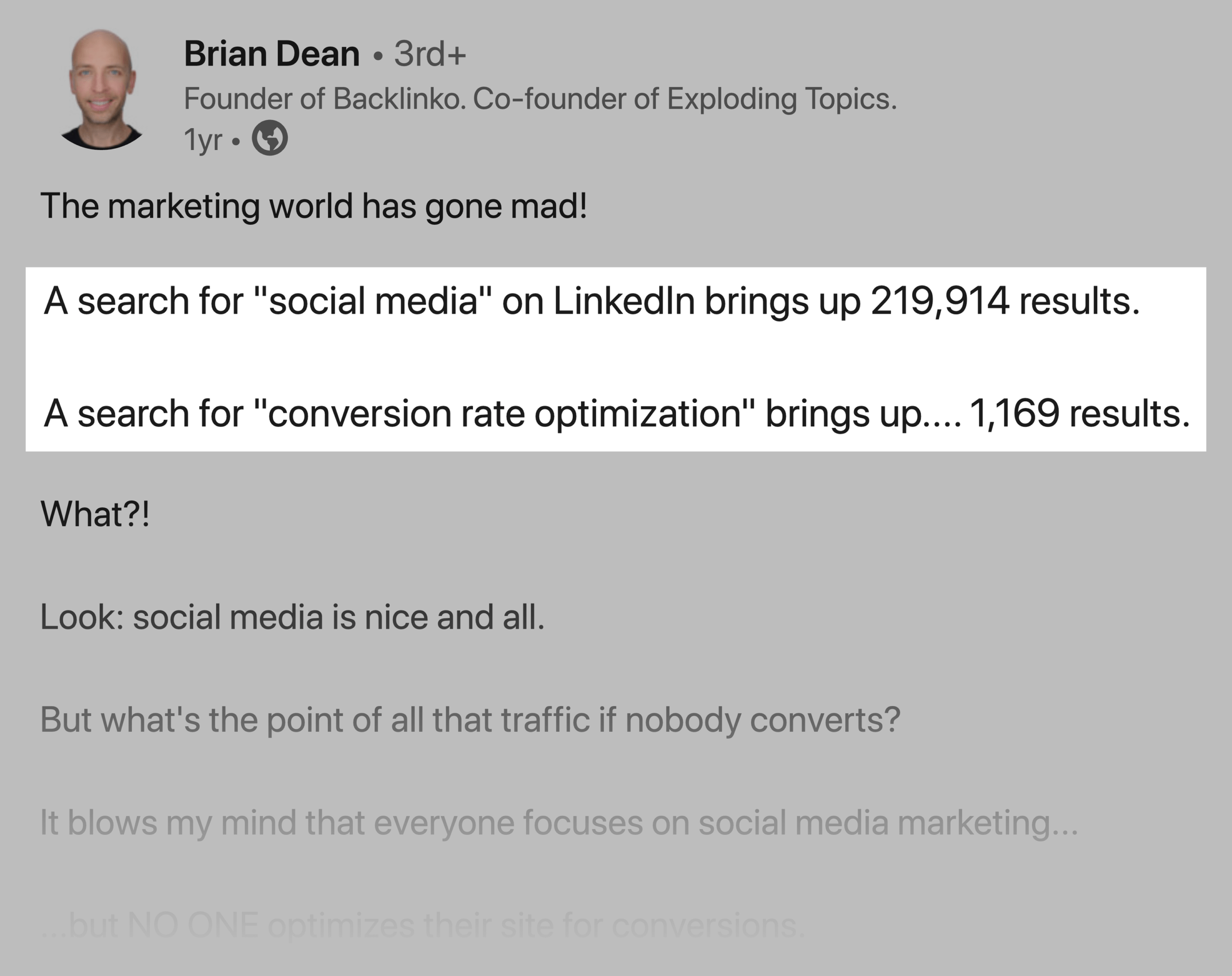
The engagement and traffic that I got from that post were 50% higher than average.
So I decided to publish even more data-driven content on LinkedIn.
On Twitter, I noticed that posts with little summaries tended to work best. Especially in bullet form.

Again, I published even more of these bulleted posts in the future.
In the case of Exploding Topics, we noticed that Twitter threads worked really well.
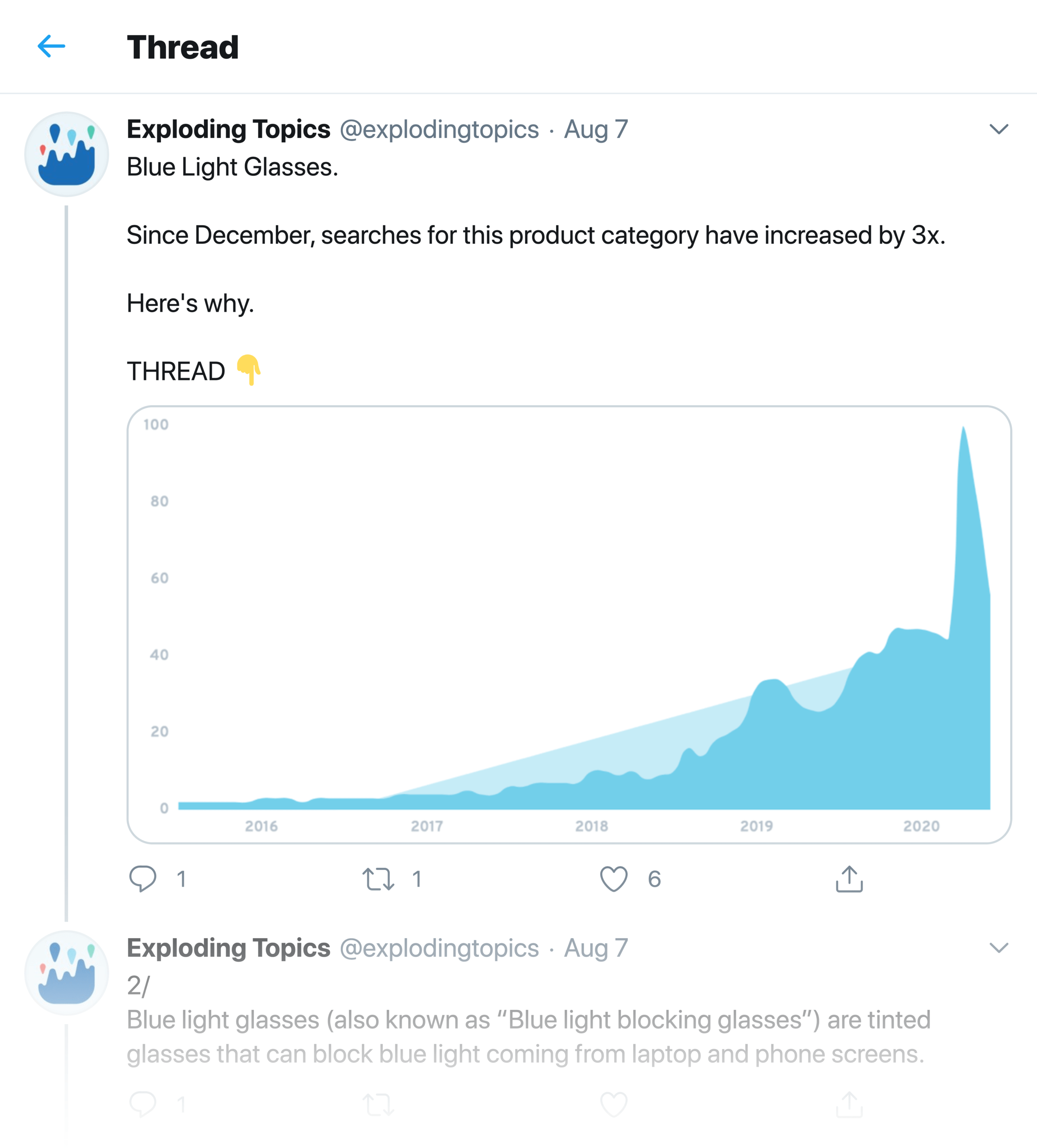
(Even though they took a lot of effort to make.)
Today, we try to publish at least 4 threads every week.
So yeah, the metrics that we talked about in the last step (traffic, conversions, followers, etc.) will tell you what you need to focus on to get results.
And what you should probably stop doing.
Step #7: Experiment With New Platforms
Once you feel that you’ve mastered a platform, it’s probably time to start a social media campaign on a different social network.
What network you jump into next depends on your business. And where potential customers hang out online.
So in most cases, the next social network to focus on will be pretty obvious.
But you can also use data to guide you.
Specifically, take a look at your social media traffic in Google Analytics.
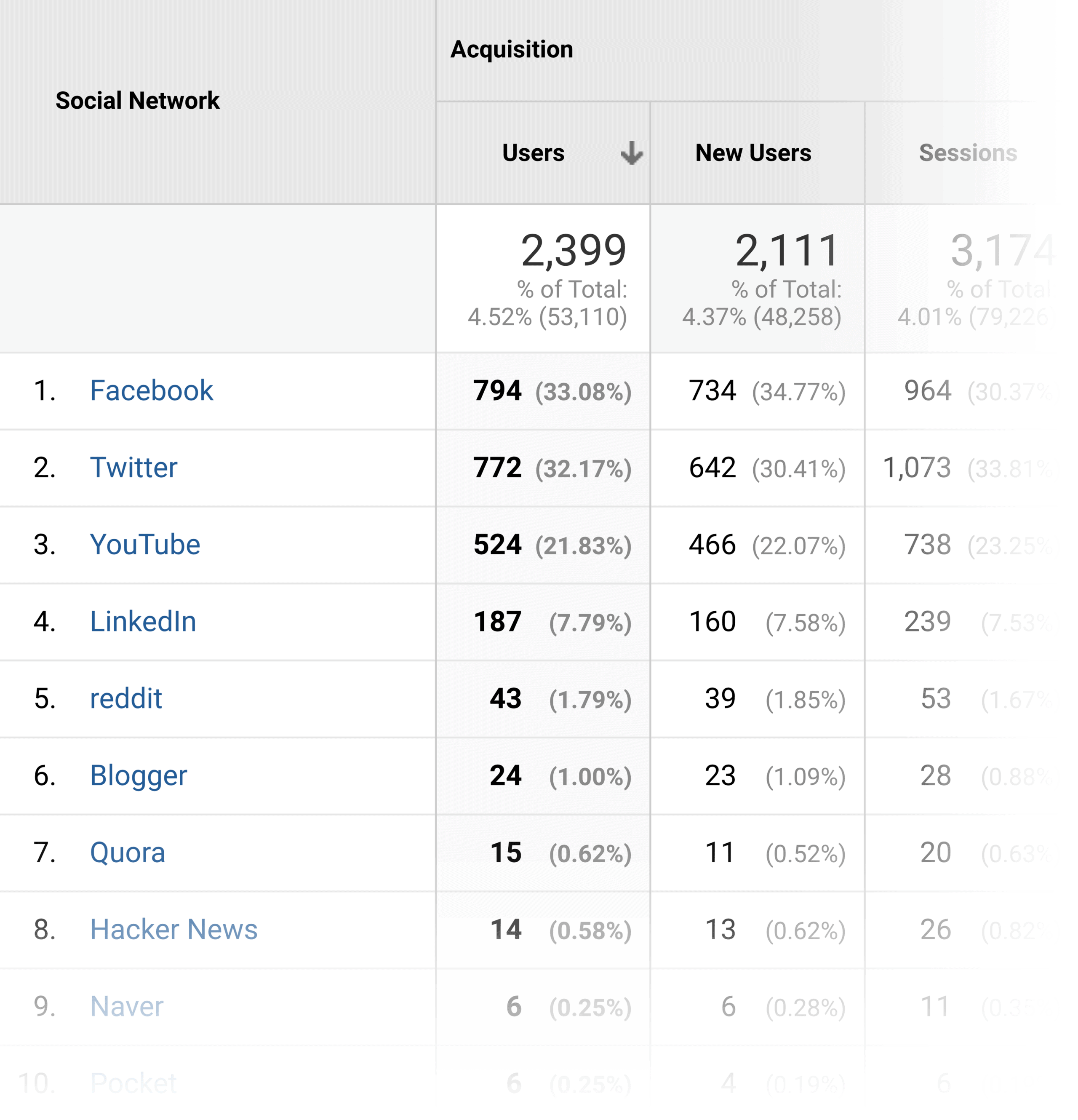
Remember: you don’t need to BE on a platform to get traffic from that platform.
So if you publish cool stuff on your blog. Or have an interesting product. People are probably already talking about your business on social media.
And you can see how that traffic converts… before jumping head first into that platform.
For example, Exploding Topics gets a small trickle of traffic from Reddit.
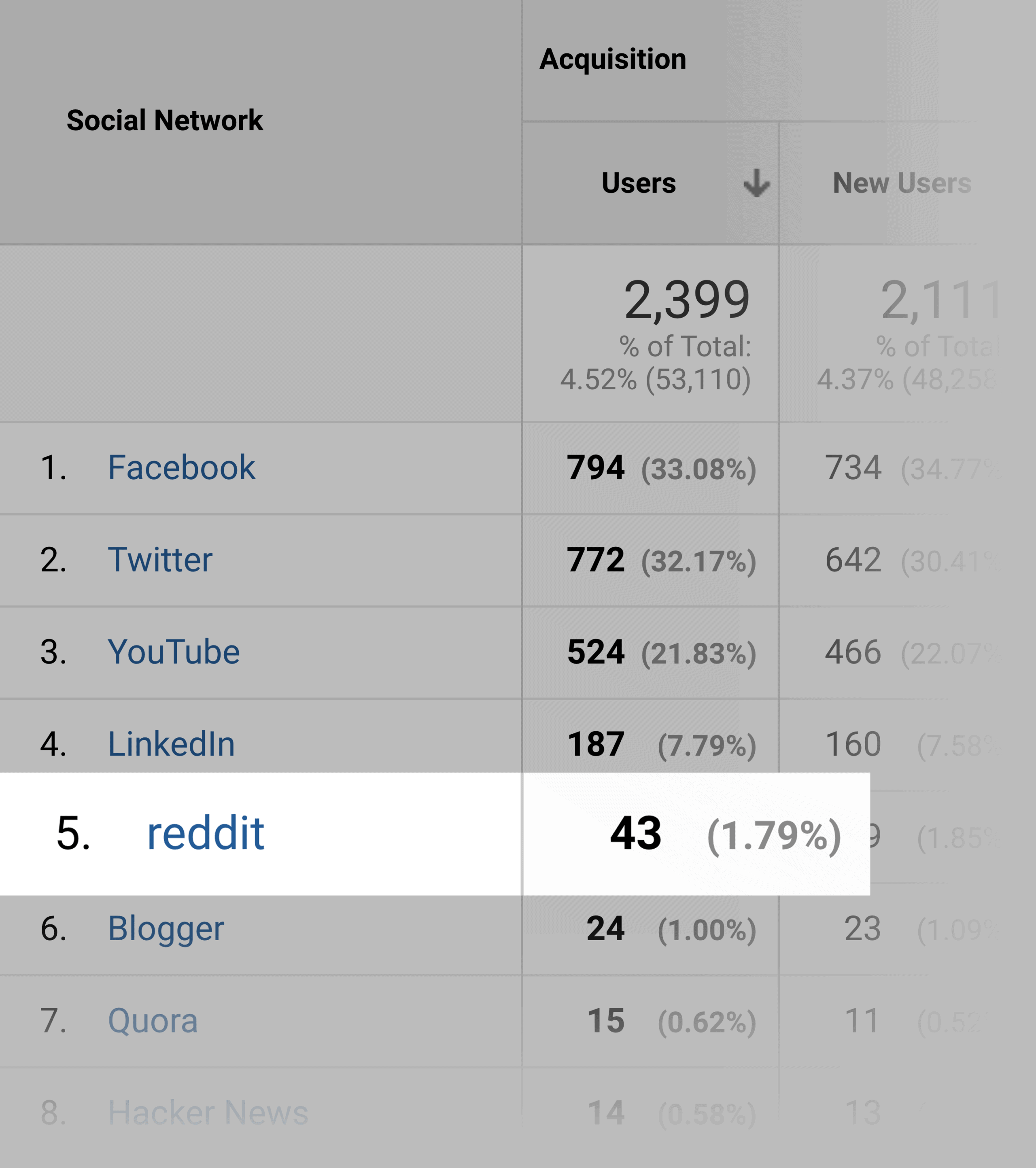
Even though we’re not remotely active there. That traffic also converts at 7%. Which is very solid.
So Reddit is probably a network that we’ll look into next.
Backlinko is owned by Semrush. We’re still obsessed with bringing you world-class SEO insights, backed by hands-on experience. Unless otherwise noted, this content was written by either an employee or paid contractor of Semrush Inc.